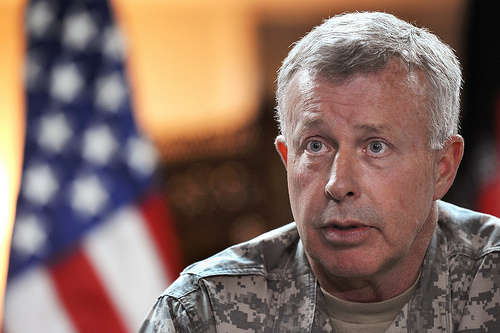
“Oh shit.” (Photo by U.S. Army.)
Never mind the climate hawks. National-security hawks ought to be seriously stressing about rapidly rising population numbers: “About 80% of the world’s civil conflicts since the 1970s have occurred in countries with young, fast-growing populations, known as youth bulges, according to an analysis by the nonprofit Population Action International.”
That’s from an L.A. Times article, “Runaway population growth often fuels youth-driven uprisings,” part of a series about population by Pulitzer Prize-winning reporter Kenneth Weiss. More from the article:
In many developing countries, runaway population growth has created vast ranks of restless young men …, with few prospects and little to lose. …
[Y]outh bulges have emerged in [Afghanistan,] Iraq, Pakistan, Yemen, Sudan, Somalia and the Palestinian territories — part of what security experts call an “arc of instability” reaching across Africa, the Middle East and South Asia.
Of the 2 billion or more people who will be added to the planet by 2050, 97% are expected to be born in Africa, Asia and Latin America, led by the poorest, most volatile countries.
American national-security planners ignored the issue for decades.
That changed on Sept. 11, 2001.
The bipartisan commission that investigated the suicide hijackings, carried out by 19 young Arab men, said one factor in the rise of extremism in the Muslim world was “a large, steadily increasing population of young men without any reasonable expectation of suitable or steady employment — a sure prescription for social turbulence.” …
In planning documents, the Pentagon and the National Intelligence Council warn of a looming “demographic crisis” in parts of Africa and Asia, where rapid population growth and climate-related disasters could help trigger famines, wars and revolutions.
Weiss reports on particularly disturbing trends in Afghanistan, which “has a birthrate of nearly seven children per woman, one of the highest in the world.”
Since the U.S.-led invasion in 2001, the population [of Afghanistan] has swelled from 23 million to 33 million. Nearly three-fourths of Afghans are under 30. The median age is 16.6, compared with 37 in the United States. …
The nonprofit International Council on Security and Development interviewed more than 420 men in Helmand and neighboring Kandahar provinces in 2010. Participants in the survey were asked, “Why do you think other Afghan men join the Taliban?” The leading reason, cited by 57%, was “jobs or money.”
Lots of idle young guys add up to lots of trouble. And with the Taliban and many other men opposing education for girls and basic rights for women, the prospects for female empowerment and widespread family-planning programs in Afghanistan are looking grim. After all, women’s rights are key to slowing population growth.
But it’s not all terrible news. Weiss reports on Iran’s family-planning successes, which have brought its fertility rate down from about seven births per woman in the 1980s to fewer than two today.
Weiss hits many more population angles in the “Beyond 7 Billion” series. (Check out Grist’s own 7 billion series for more still.)



